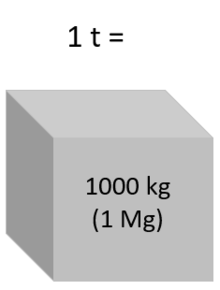
Tonne

The tonne (/tʌn/ (listen); non-SI unit, symbol: t), commonly referred to as the metric ton in the United States and Canada, is a non-SI metric unit of mass equal to 1,000 kilograms or one megagram (symbol: Mg). It is equivalent to approximately 2,204.6 pounds, 1.102 short tons (US) or 0.984 long tons (UK). Although not part of the SI, the tonne is accepted for use with SI units and prefixes by the International Committee for Weights and Measures.'Tungsten concentrates are usually traded in metric tonne units (originally designating one tonne of ore containing 1% of WO3, today used to measure WO3 quantities in 10 kg units. One metric tonne unit (mtu) of tungsten (VI) contains 7.93 kilograms of tungsten.' (Walter L Pohl, Economic Geology: Principles and Practices, English edition, 2011, p 183.) The tonne (/tʌn/ (listen); non-SI unit, symbol: t), commonly referred to as the metric ton in the United States and Canada, is a non-SI metric unit of mass equal to 1,000 kilograms or one megagram (symbol: Mg). It is equivalent to approximately 2,204.6 pounds, 1.102 short tons (US) or 0.984 long tons (UK). Although not part of the SI, the tonne is accepted for use with SI units and prefixes by the International Committee for Weights and Measures. The tonne is derived from the mass of one cubic metre of pure water; one thousand litres of pure water has an absolute mass of one tonne. The SI symbol for the tonne is 't', adopted at the same time as the unit in 1879. Its use is also official for the metric ton in the United States, having been adopted by the United States National Institute of Standards and Technology. It is a symbol, not an abbreviation, and should not be followed by a period. Use of majuscule and minuscule letter case is significant, and use of other letter combinations is not permitted and would lead to ambiguity. For example, 'T', 'MT', 'Mt', 'mt' are the SI symbols for the tesla, megatesla, megatonne (one teragram) and millitonne (one kilogram) respectively. If describing TNT equivalent units of energy, this is equivalent to 4.184 petajoules. In French and most varieties of English (the exceptions being American and occasionally Canadian English), tonne is the correct spelling. It is usually pronounced the same as ton /tʌn/, but when it is important to clarify that the metric term is meant, rather than short ton, the final 'e' can also be pronounced, i.e. 'tuhnny' /ˈtʌnɪ/. In Australia, it is also pronounced /tɒn/. Before metrication in the UK the unit used for most purposes was the Imperial ton of 2,240 pounds avoirdupois or 20 hundredweight (usually referred to as the long ton in the US), equivalent to 1,016 kg, differing by just 1.6% from the tonne. The UK Weights and Measures Act 1985 explicitly excluded from use for trade certain imperial units, including the ton, unless the item being sold or the weighing equipment being used was weighed or certified prior to 1 December 1980, and even then only if the buyer was made aware that the weight of the item was measured in imperial units. In the United States metric ton is the name for this unit used and recommended by NIST; an unqualified mention of a ton almost invariably refers to a short ton of 2,000 pounds (907 kg), and tonne is rarely used in speech or writing. Both spellings are acceptable in Canadian usage. Ton and tonne are both derived from a Germanic word in general use in the North Sea area since the Middle Ages (cf. Old English and Old Frisian tunne, Old High German and Medieval Latin tunna, German and French tonne) to designate a large cask, or tun. A full tun, standing about a metre high, could easily weigh a tonne. An English tun (an old wine cask volume measurement equivalent to nine hundred, and fifty-four litres) of wine has a relative mass of one tonne, nine hundred, and fifty-four kg if full of pure water, a little less for wine. The spelling tonne pre-dates the introduction of the SI in 1960; it has been used with this meaning in France since 1842, when there were no metric prefixes for multiples of 106 and above, and is now used as the standard spelling for the metric mass measurement in most English-speaking countries. In the United States, the unit was originally referred to using the French words millier or tonneau, but these terms are now obsolete. The Imperial and US customary units comparable to the tonne are both spelled ton in English, though they differ in mass.
